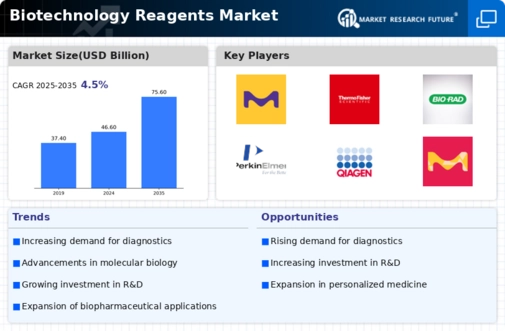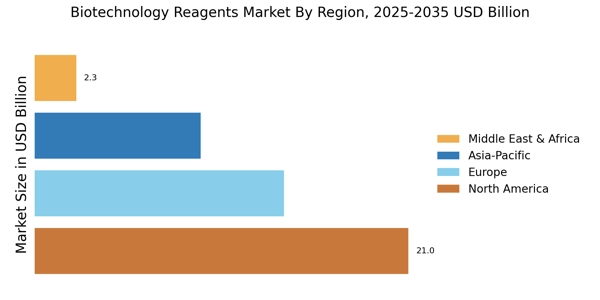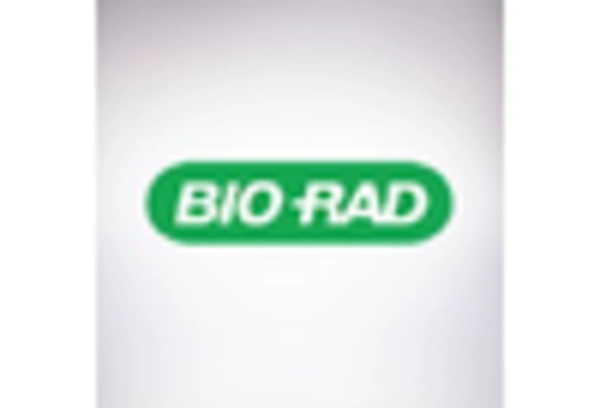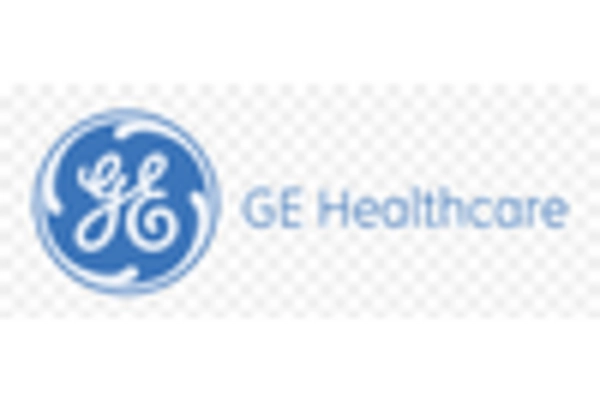Growing Biopharmaceutical Sector
The biopharmaceutical sector is experiencing rapid growth, which is a key driver for the Biotechnology Reagents Market. With an increasing number of biologics and biosimilars entering the market, the demand for high-quality reagents used in their development and production is on the rise. Recent reports indicate that the biopharmaceutical market is projected to reach USD 500 billion by 2025, underscoring the sector's expansion. This growth is likely to necessitate the use of advanced reagents for various applications, including cell culture, purification, and quality control. As biopharmaceutical companies strive to meet regulatory standards and ensure product efficacy, the Biotechnology Reagents Market stands to gain from the heightened demand for specialized reagents tailored to biopharmaceutical applications.
Rising Demand for Diagnostic Testing
The increasing prevalence of chronic diseases and genetic disorders is driving the demand for diagnostic testing, which in turn propels the Biotechnology Reagents Market. As healthcare systems emphasize early detection and personalized treatment, the need for high-quality reagents becomes paramount. According to recent estimates, the diagnostic testing market is projected to reach USD 70 billion by 2026, indicating a robust growth trajectory. This surge is likely to stimulate innovation in reagent development, enhancing their specificity and sensitivity. Consequently, manufacturers are focusing on producing advanced reagents that cater to diverse diagnostic applications, thereby expanding their market presence. The Biotechnology Reagents Market is thus positioned to benefit from this trend, as the demand for reliable and efficient diagnostic tools continues to escalate.
Increased Investment in Biotechnology
Investment in biotechnology is witnessing a notable increase, which is positively impacting the Biotechnology Reagents Market. Venture capital funding and government grants are being directed towards innovative biotech startups and established companies alike, fostering an environment conducive to growth. Data indicates that venture capital investments in biotechnology reached approximately USD 20 billion in 2025, reflecting a strong interest in the sector. This influx of capital is likely to accelerate the development of new reagents and technologies, enhancing the overall market landscape. As companies leverage these investments to innovate and expand their product offerings, the Biotechnology Reagents Market is expected to experience significant growth driven by enhanced research capabilities and product diversification.
Advancements in Research and Development
Ongoing advancements in research and development within the biotechnology sector are significantly influencing the Biotechnology Reagents Market. The continuous evolution of technologies such as CRISPR, next-generation sequencing, and proteomics is creating a fertile ground for the development of innovative reagents. As researchers seek to explore complex biological systems, the demand for specialized reagents that can facilitate these studies is likely to increase. Market data suggests that the R&D expenditure in biotechnology is expected to surpass USD 300 billion by 2025, highlighting the sector's commitment to innovation. This investment is anticipated to lead to the introduction of novel reagents that enhance experimental accuracy and efficiency, thereby driving growth in the Biotechnology Reagents Market.
Regulatory Support for Biotechnology Innovations
Regulatory bodies are increasingly supporting biotechnology innovations, which is a crucial driver for the Biotechnology Reagents Market. Streamlined approval processes and favorable policies are encouraging the development and commercialization of new reagents. Recent initiatives aimed at expediting the review of biotechnological products are likely to enhance market accessibility for innovative reagents. This regulatory support is essential for fostering a competitive environment where companies can introduce cutting-edge products. As the regulatory landscape evolves to accommodate advancements in biotechnology, the Biotechnology Reagents Market is poised to benefit from increased product launches and market entries, ultimately contributing to its growth.


















Leave a Comment